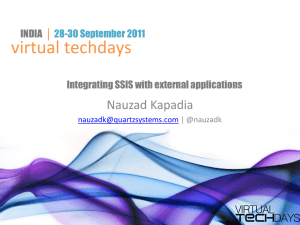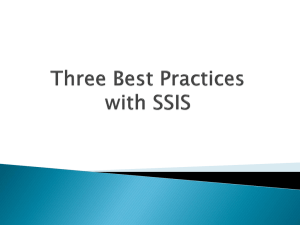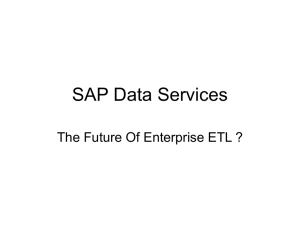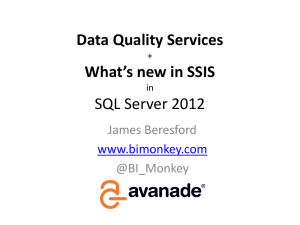Design and implement a data warehouse (no change: 10
advertisement
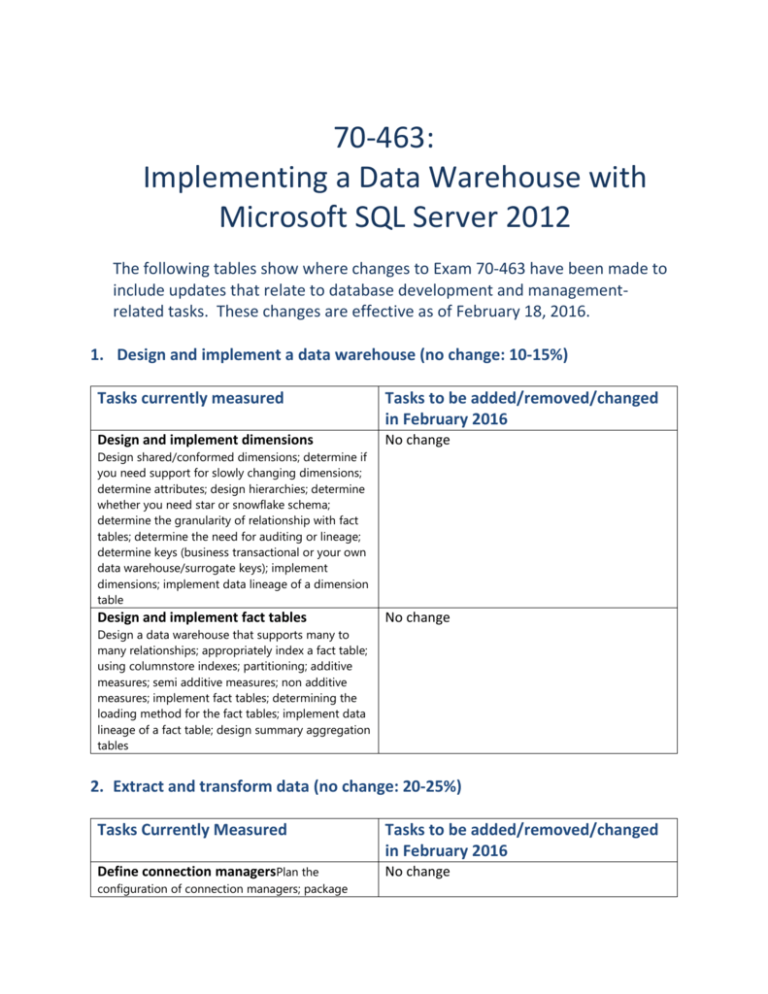
70-463: Implementing a Data Warehouse with Microsoft SQL Server 2012 The following tables show where changes to Exam 70-463 have been made to include updates that relate to database development and managementrelated tasks. These changes are effective as of February 18, 2016. 1. Design and implement a data warehouse (no change: 10-15%) Tasks currently measured Tasks to be added/removed/changed in February 2016 Design and implement dimensions No change Design shared/conformed dimensions; determine if you need support for slowly changing dimensions; determine attributes; design hierarchies; determine whether you need star or snowflake schema; determine the granularity of relationship with fact tables; determine the need for auditing or lineage; determine keys (business transactional or your own data warehouse/surrogate keys); implement dimensions; implement data lineage of a dimension table Design and implement fact tables No change Design a data warehouse that supports many to many relationships; appropriately index a fact table; using columnstore indexes; partitioning; additive measures; semi additive measures; non additive measures; implement fact tables; determining the loading method for the fact tables; implement data lineage of a fact table; design summary aggregation tables 2. Extract and transform data (no change: 20-25%) Tasks Currently Measured Tasks to be added/removed/changed in February 2016 Define connection managersPlan the No change configuration of connection managers; package level or project level connection manager; define a connection string; parameterization of connection strings Design data flow Define data sources and destinations; distinguish blocking and non-blocking transformations; use different methods to pull out changed data from data sources; determine appropriate data flow components; determine the need for supporting Slowly Changing Dimensions (SCD); determine whether to use SQL Joins or SSIS lookup or merge join transformations; batch processing versus row by row processing; determine the appropriate transform to use for a specific task; determine the need and method for identity mapping and deduplicating; fuzzy lookup, fuzzy grouping and Data Quality Services (DQS) transformation; determine the need for text mining; determine the need for custom data sources, destinations, and transforms; determine what to do with erroneous rows; determine auditing needs; determine sampling needs for data mining (advanced); trusted/authoritative data sources, including warehouse metadata Implement data flow Removed subtasks: determine the need for text mining; determine sampling needs for data mining (advanced) Additional subtask: extracting only changed rows No change Debug data flow; use the appropriate data flow components; SQL / SSIS data transformation; create SSIS packages that support slowly changing dimensions; use the lookup task in SSIS; map identities using SSIS fuzzy lookup (advanced); specify a data source and destination; use data flows; different categories of transformations; read, transform and load data; understand which transforms to use to accomplish a specific business task; data correction transformation; performance tune an SSIS dataflow; optimize Integration Services packages for speed of execution; maintain data integrity, including good data flow Manage SSIS package execution No change Schedule package execution by using SQL Server Agent; execute packages by using DTEXEC; execute packages by using SQL Server Management Studio; implement package execution; plan and design package execution strategy; use PowerShell to execute script; monitor the execution using Management Studio; use DTEXECUI; ETL restartability Implement script tasks in SSIS Determine if it is appropriate to use a script task; extending the capability of a control flow; perform a No change custom action as needed (not on every row) during a control flow 3. Load data (no change: 25-30%) Tasks Currently Measured Tasks to be added/removed/changed in February 2016 Design control flow No change Determine control flow; determine containers and tasks needed; determine precedence constraints; design an SSIS package strategy with rollback, staging and transaction control; decide between one package or multiple packages; determine event handlers; determine variables; determine parameters on package and project level; determine connection managers and whether they are package or project level; determine the need for custom tasks; determine how much information you need to log from a package; determine the need for checkpoints; determine security needs Implement package logic by using SSIS variables and parameters No change User variables; variable scope, data type; implement parameterization of properties using variables; using variables in precedence constraints; referring to SSIS system variables; design dynamic SSIS packages; package configurations (file or SQL tables); expressions; package and project parameters; project level connection managers; variables; implement dynamic package behavior; configure packages in SSIS for different environments, package configurations (xmlconfiguration file, SQLServer table, registry entry; parent package variables, environment variable); parameters (package and project level); project connection managers; property expressions (use expressions for connection managers) Implement control flow No change Checkpoints; debug control flow; implement the appropriate control flow task to solve a problem; data profiling; use sequence containers and loop containers; manage transactions in SSIS packages; managing parallelism; using precedence constraint to control task execution sequence; creating package templates; using the execute package task Implement data load options Additional subtasks: Implement a full and incremental data load strategy; plan for an incremental update of the relational Data Mart Plan for loads into indexed tables, configure appropriate bulk load options, select an appropriate load technique (SSIS Destination vs TSQL) and load partitioned tables Implement script components in SSIS No change Create an SSIS package that handles SCD Type 2 changes without using the SCD component; work with script component in SSIS; deciding when it is appropriate to use a script component versus a built in; source, transformation, destination component; use cases: web service source and destination, getting the error message 4. Configure and deploy SSIS solutions (no change: 20-25%) Tasks Currently Measured Tasks to be added/removed/changed in February 2016 Troubleshoot data integration issue No change Performance issues; connectivity issues; execution of a task or transformation failed; logic issues; demonstrate awareness of the new SSIS logging infrastructure; troubleshoot a failed package execution to determine the root cause of failure; troubleshoot SSIS package failure from an invalid datatype; implement break points; data viewers; profile data with different tools; batch cleanup Install and maintain SSIS components No change Software installation (IS, management tools); development box and server; install specifics for remote package execution; planning for installation (32- versus 64-bit); upgrade; provisioning the accounts; creating the catalog Implement auditing, logging, and event handling No change Audit package execution by using system variables; propagate events; use log providers; log an SSIS execution; create alerting and notification mechanisms; use Event Handlers in SSIS to track ETL events and errors; implement custom logging Deploy SSIS solutions No change Create and configure an SSIS catalog; deploy SSIS packages by using the deployment utility; deploy SSIS packages to SQL or file system locations; validate deployed packages; deploy packages on multiple servers; how to install custom components and tasks; deploy SSIS packages by using DTUTIL Configure SSIS security settings SSIS catalog database roles; package protection levels; secure Integration Services packages that are deployed at the file system; secure Integration Services parameters, configuration No change 5. Build data quality solutions (no change: 15-20%) Tasks Currently Measured Tasks to be added/removed/changed in February 2016 Install and maintain data quality services No change Installation prerequisites; .msi package; adding users to the DQ roles; identity analysis, including data governance Implement master data management solutions No change Install Master Data Services (MDS); implement MDS; create models, entities, hierarchies, collections, attributes; define security roles; import/export; subscriptions Create a data quality project to clean data Profile Online Transaction Processing (OLTP) and other source systems; data quality knowledge base management; create data quality project; use data quality client; improve data quality; identity mapping and deduplicating; handle history and data quality; manage data quality/cleansing No change
